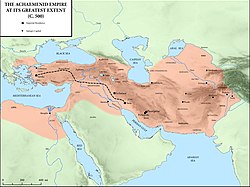Yehud Medinata
Yehud Medinata (Aramaic for the State of Judah), or simply Yehud, was part of the Persian Achaemenid Empire. It was located within the satrapy of Eber-Nari.
Yehud State Yehud Medinata | |||||||||
|---|---|---|---|---|---|---|---|---|---|
| c. 539 BCE–c. 332 BCE | |||||||||
| Yehud Medinata (in pink) under the Persian Empire Yehud Medinata (in pink) under the Persian Empire | |||||||||
| Status | Province of the Achaemenid Empire | ||||||||
| Capital | Jerusalem 31°47′N 35°13′E / 31.783°N 35.217°ECoordinates: 31°47′N 35°13′E / 31.783°N 35.217°E | ||||||||
| Common languages | Aramaic, Hebrew, Old Persian | ||||||||
| Religion | Second Temple Judaism | ||||||||
| History | |||||||||
• | c. 539 BCE | ||||||||
• | c. 332 BCE | ||||||||
| Currency | Daric, siglos | ||||||||
| |||||||||
| Today part of | |||||||||
Overview
Yehud Medinata was similar to the older Kingdom of Judah but had a smaller territory. The area of Yehud Medinata is roughly the same as the previous Babylonian province of Yehud, created after the Kingdom of Judah was invaded by the Neo-Babylonian Empire (c. 597). Yehud Medinata continued to exist for two centuries, until the Greek Macedonian emperor Alexander the Great conquered it and made it part of his empire.
History
The exact period for Babylonian and Persian rule is still under debate.
| Year | Event |
|---|---|
| 587 BCE | Conquest of Jerusalem by Babylonians; second deportation (first deportation in 597); Gedaliah installed as governor in Mizpah |
| 582? BCE | Assassination of Gedaliah; refugees flee to Egypt; third deportation to Babylon |
| 562 BCE | Jeconiah, king of Judah deported and imprisoned in Babylon in 597, released; remains in Babylon |
| 539 BCE | Cyrus the Great (Cyrus II, ruled c.550-530 BCE) conquers Babylon |
| 538 BCE | "Declaration of Cyrus" allowing Jews to return to Jerusalem |
| 530 BCE | Cambyses II (ruled 530-522 BCE) succeeds Cyrus |
| 525 BCE | Cambyses conquers Egypt |
| 522 BCE | Darius I (ruled 522 ‒ 486 BCE) succeeds Cambyses |
| 521 BCE | Negotiations in Babylon between Darius and the exiled Jews |
| 520 BCE[1] | Return to Jerusalem of Zerubbabel as governor of Yehud and Joshua as High Priest |
| 520-515 BCE[1] | Rebuilding of the Temple (Second Temple) |
| 458? BCE | Arrival in Jerusalem of Ezra (7th year of the reign of Artaxerxes I, king 465-424 BCE) |
| 445/444 BCE | Arrival in Jerusalem of Nehemiah (20th year of the reign of Artaxerxes I) |
| 397? BCE (possible) |
Arrival in Jerusalem of Ezra (7th year of the reign of Artaxerxes II, king 404-358 BCE) |
| 333/332 BCE | Alexander the Great conquers the Mediterranean provinces of Persian Empire; beginning of Hellenistic age |
Yehud Medinata Media
Shamash-sun-symbol (3 rays)
The Achaemenid Empire at its greatest extent, including the province of Yehud.
Silver coin (gerah) minted in the Persian province of Yehud, dated c. 375–332 BCE. Obv: Bearded head wearing crown, possibly representing the Persian Great King. Rev: Falcon facing, head right, with wings spread; Paleo-Hebrew YHD to right.
- YHD coins.jpg
Coins attributed to the region. The God on the Winged Wheel coin (top) may show the god Yahweh. The coin at bottom right has an image of the owl of Athena (Athenian coinage was the standard for Mediterranean trade).
- JUDAEA, Persian Period. Hezekiah. Circa 375-333 BCE.jpg
Coin of Hezekiah, Satrap of Judaea, Achaemenid period. Circa 375–333 BCE.
Related pages
References
Other websites
Maps
- Yehud Medinata map, CET – Center For Educational technology
- Yehud Medinata Border map, CET – Center For Educational technology
Books
- Bob Becking; Marjo Christina Annette Korpel (1999). The crisis of Israelite religion: transformation of religious tradition in exilic and post-exilic times. BRILL. ISBN 90-04-11496-3.
- Bedford, Peter Ross (2001). Temple Restoration in Early Achaemenid Judah. BRILL. ISBN 90-04-11509-9.
- Berquist, Jon L. (2007). Approaching Yehud: New Approaches to the Study of the Persian Period. Society of Biblical Literature. p. 195. ISBN 978-1-58983-145-2.
- Blenkinsopp, Joseph (2009). Judaism, the First Phase: The Place of Ezra and Nehemiah in the Origins of Judaism. Wm. B. Eerdmans Publishing. ISBN 978-0-8028-6450-5.
- Grabbe, Lester L. (2006). A History of the Jews and Judaism in the Second Temple Period (vol. 1): The Persian Period (539-331BCE). Bloomsbury Academic. p. 85. ISBN 978-0-567-04352-8.
- Levine, Lee I. (2002). Jerusalem: Portrait of the City in the Second Temple Period (538 B.C.E. ? 70 C.E.). Jewish Publication Society. p. 196. ISBN 978-0-8276-0750-7.
- Lipschitz, Oded (2005). The Fall and Rise of Jerusalem: Judah Under Babylonian Rule. Eisenbrauns. ISBN 978-1-57506-095-8.
- Lipschitz, Oded; Oeming, Manfred (2006). Judah and the Judeans in the Persian Period. Eisenbrauns. ISBN 978-1-57506-104-7.
- Lipschitz, Oded; Knoppers, Gary N.; Albertz, Rainer (2007). Judah and the Judeans in the Fourth Century B.C.E. Eisenbrauns. p. 75. ISBN 978-1-57506-130-6.
- Middlemas, Jill (2005). The Troubles of Templeless Judah. Oxford University Press. ISBN 978-0-19-928386-6.
- Stackert, Jeffrey (2007). Rewriting the Torah: Literary Revision in Deuteronomy and the Holiness Legislation. Mohr Siebeck. ISBN 978-3-16-149298-3.
- Nodet, Etienne (1997). A Search for the Origins of Judaism: From Joshua to the Mishnah. A&C Black. ISBN 978-1-85075-445-9.
- Vanderkam, James C. (2001). An Introduction to Early Judaism. Wm. B. Eerdmans Publishing. ISBN 978-0-8028-4641-9.


